Reduction of Environmental Impacts Due to Using Permeable Pavements to Harvest Stormwater
Abstract
1. Introduction
2. Method
2.1. Permeable Pavement and Quality of Stormwater
2.2. Potential for Potable Water Savings
2.3. Lifecycle Environmental Impacts
2.4. Lifecycle Cost Analysis
3. Results and Discussion
3.1. Water Consumption and Water End-Uses by Residents in Glasgow
3.2. Daily Rainfall Data
3.3. Total Surface Area of Paved Roads
3.4. Potential for Potable Water Savings
3.5. Permeable Pavement Hydraulic Design
3.6. Lifecycle Environmental Impacts
3.7. Lifecycle Cost Analysis
4. Conclusions
Supplementary Materials
Author Contributions
Funding
Conflicts of Interest
References
- Tedoldi, D.; Chebbo, G.; Pierlot, D.; Kovacs, Y.; Gromaire, M. Impact of runoff infiltration on contaminant accumulation and transport in the soil/filter media of Sustainable Urban Drainage Systems: A literature review. Sci. Total Environ. 2016, 569, 904–926. [Google Scholar] [CrossRef] [PubMed]
- Wang, S.; Wang, H. Extending the Rational Method for assessing and developing sustainable urban drainage systems. Water Res. 2017, 144, 112–125. [Google Scholar] [CrossRef] [PubMed]
- Stott, P. How climate change affects extreme weather events. Science 2016, 353, 1517–1518. [Google Scholar] [CrossRef] [PubMed]
- Scholz, M.; Grabowiecki, P. Review of porous pavement systems. Build. Environ. 2007, 42, 3830–3836. [Google Scholar] [CrossRef]
- Pagotto, C.; Legret, M.; Le Cloirec, P. Comparison of the hydraulic behaviour and the quality of highway runoff water according to the type of pavement. Water Res. 2000, 34, 4446–4454. [Google Scholar] [CrossRef]
- Brattebo, B.O.; Booth, D.B. Long-term stormwater quantity and quality performance of porous pavement systems. Water Res. 2003, 37, 4369–4376. [Google Scholar] [CrossRef]
- Newman, A.P.; Aitken, D.; Antizar-Ladislao, B. Stormwater quality performance of a macro-permeable pavement car park installation equipped with channel drain based oil and silt retention devices. Water Res. 2013, 47, 7327–7336. [Google Scholar]
- Nnadi, E.O.; Newman, A.P.; Coupe, S.J.; Mbanaso, F.U. Stormwater harvesting for irrigation purposes: An investigation of chemical quality of water recycled in permeable pavement system. J. Environ. Manag. 2015, 147, 246–256. [Google Scholar] [CrossRef]
- Knabben, R.M.; Trichês, G.; Gerges, S.N.Y.; Vergara, E.F. Evaluation of sound absorption capacity of asphalt mixtures. Appl. Acoust. 2016, 114, 266–274. [Google Scholar]
- Qin, Y. A review on the development of cool pavements to mitigate urban heat island effect. Renew. Sustain. Energy Rev. 2015, 52, 445–459. [Google Scholar] [CrossRef]
- Khankhaje, E.; Rafieizonooz, M.; Salim, M.R.; Khan, R.; Mirza, J.; Siong, H.C.; Salmiati, S. Sustainable clean permeable concrete pavement production incorporating palm oil fuel ash as cement replacement. J. Clean. Prod. 2018, 172, 1476–1485. [Google Scholar] [CrossRef]
- Kevern, J.T.; Schaefer, V.R.; Wang, K. Mixture Proportion Development and Performance Evaluation of Permeable Concrete for Overlay Applications. ACI Mater. J. 2011, 108, 439–448. [Google Scholar]
- Selbig, W.R.; Buer, N.; Danz, M.E. Stormwater-quality performance of lined permeable pavement systems. J. Environ. Manag. 2019, 251, 109510. [Google Scholar] [CrossRef] [PubMed]
- Bean, E.Z.; Hunt, W.F.; Bidelspach, D.A. Evaluation of Four Permeable Pavement Sites in Eastern North Carolina for Runoff Reduction and Water Quality Impacts. J. Irrig. Drain. Eng. 2007, 33, 583. [Google Scholar] [CrossRef]
- Pilon, B.S.; Tyner, J.S.; Yoder, D.C.; Buchanan, J.R. The Effect of Permeable Concrete on Water Quality Parameters: A Case Study. Water 2019, 11, 263. [Google Scholar] [CrossRef]
- Huang, J.; He, J.; Valeo, C.; Chu, A. Temporal evolution modeling of hydraulic and water quality performance of permeable pavements. J. Hydrol. 2016, 533, 15–27. [Google Scholar] [CrossRef]
- Liu, Y.; Bralts, V.F.; Engel, B.A. Evaluating the effectiveness of management practices on hydrology and water quality at watershed scale with a rainfall-runoff model. Sci. Total. Environ. 2015, 511, 298–308. [Google Scholar] [CrossRef]
- Gulotta, T.M.; Mistretta, M.; Praticò, F.G. A life cycle scenario analysis of different pavement technologies for urban roads. Sci. Total. Environ. 2019, 673, 585–593. [Google Scholar] [CrossRef]
- Zhang, Z.; Sha, A.; Liu, X.; Luan, B.; Gao, J.; Jiang, W.; Ma, F. State-of-the-art of porous asphalt pavement: Experience and considerations of mixture design. Constr. Build. Mater. 2020, 262, 119998. [Google Scholar]
- Antunes, L.N.; Ghisi, E.; Thives, L.P. Permeable pavements life cycle assessment: A literature review. Water 2018, 10, 1575. [Google Scholar] [CrossRef]
- Liu, J.; Li, H.; Wang, Y.; Zhang, H. Integrated life cycle assessment of permeable pavement: Model development and case study. Transp. Res. Part D Transp. Environ. 2020, 85, 102381. [Google Scholar] [CrossRef]
- Turco, M.; Brunetti, G.; Palermo, S.A.; Capano, G.; Grossi, G.; Maiolo, M.; Piro, P. On the environmental benefits of a permeable pavement: Metals potential removal efficiency and Life Cycle Assessment. Urban Water J. 2020. [Google Scholar] [CrossRef]
- Bhatt, A.; Bradford, A.; Abbassi, B.E. Cradle-to-grave life cycle assessment (LCA) of low-impact-development (LID) technologies in southern Ontario. J. Environ. Manag. 2019, 231, 98–109. [Google Scholar] [CrossRef] [PubMed]
- Lu, G.; Wang, Y.; Li, H.; Wang, D.; Oeser, M. The environmental impact evaluation on the application of permeable pavement based on life cycle analysis. Int. J. Transp. Sci. Technol. 2019, 8, 351–357. [Google Scholar]
- Vaz, I.C.M.; Ghisi, E.; Thives, L.P. Life cycle energy assessment and economic feasibility of stormwater harvested from permeable pavements. Water Res. 2020, 170, 115322. [Google Scholar]
- American Society of Civil Engineers (ASCE). Permeable Pavements: Recommended Design Guidelines; American Society of Civil Engineers: Reston, VA, USA, 2013; ISBN 9780784478677. [Google Scholar]
- Agência Nacional de Águas (ANA). Water Conservation and Reuse in Buildings; Editora Gráfica: São Paulo, Brazil, 2005. Available online: http://az545403.vo.msecnd.net/uploads/2014/08/conservacao-e-reuso-de-aguas-2005.pdf (accessed on 20 April 2020).
- Deletic, A. The first flush load of urban surface runoff. Water Res. 1998, 32, 2462–2470. [Google Scholar] [CrossRef]
- Ghisi, E.; Cordova, M.M. Netuno 4. Programa Computacional; Federal University of Santa Catarina, Department of Civil Engineering: Florianópolis, Brazil, 2014; Available online: http://www.labeee.ufsc.br/ (accessed on 15 April 2020).
- Scottish Environment Protection Agency. Rainfall Data for Scotland. Available online: https://apps.sepa.org.uk/rainfall (accessed on 6 June 2020).
- Google Earth. Available online: https://www.google.co.uk/intl/en_uk/earth/ (accessed on 18 June 2020).
- Transport Scotland. Scottish Transport Statistics N° 37 2018 Edition. Edinburgh, UK, 2019. Available online: https://www.transport.gov.scot/media/44025/scottish-transport-statistics-no-37-2018-edition.pdf (accessed on 18 July 2020).
- Hammes, G.; Thives, L.P.; Ghisi, E. Application of stormwater collected from permeable asphalt pavements for non-potable uses in buildings. J. Environ. Manag. 2018, 222, 338–347. [Google Scholar] [CrossRef]
- Garcia, S.H.E.; Thives, L.P.; Ghisi, E.; Antunes, L.N. Analysis of permeability reduction in drainage asphalt mixtures due to decrease in void volume. J. Clean. Prod. 2020, 248, 119292. [Google Scholar] [CrossRef]
- ISO 14040—Environmental Management. Life Cycle Assessment, Principles and Framework, 2006. Available online: https://www.iso.org/obp/ui/#iso:std:iso:14040:ed-2:v1:en (accessed on 14 July 2020).
- ISO 14044—Environmental Management. Life Cycle Assessment, Requirements and Guidelines, 2006. Available online: https://www.iso.org/obp/ui/#iso:std:iso:14044:ed-1:v1:en (accessed on 14 July 2020).
- Antunes, L.N.; Ghisi, E.; Severis, R.M. Environmental assessment of a permeable pavement system used to harvest stormwater for non-potable water uses in a building. Sci. Total Environ. 2020, 746, 141087. [Google Scholar] [CrossRef]
- Marinoski, A.K.; Ghisi, E. Environmental performance of hybrid rainwater-greywater systems in residential buildings. Resour. Conserv. Recycl. 2019, 144, 100–114. [Google Scholar] [CrossRef]
- Wernet, G.; Bauer, C.; Steubing, B.; Reinhard, J.; Moreno-Ruiz, E.; Weidema, B. The ecoinvent database version 3 (part I): Overview and methodology. Int. J. Life Cycle Assess. 2016, 21, 1218–1230. [Google Scholar]
- Huijbregts, M.A.J.; Steinmann, Z.J.N.; Elshout, P.M.F.; Stam, G.; Verones, F.; Vieira, M.D.M.; Zijp, M.; Hollander, A.; Zelm, R. ReCiPe2016: A harmonised life cycle impact assessment method at midpoint and endpoint level. Int. J. Life Cycle Assess. 2017, 22, 138–147. [Google Scholar]
- Scottish Government. Building Standards Technical Handbook 2017: Domestic Buildings. Available online: https://www.gov.scot/publications/building-standards-2017-domestic/1-structure/10-introduction/ (accessed on 25 April 2020).
- UK Population. Glasgow Population, 2019. Available online: https://www.ukpopulation.org/glasgow-population/ (accessed on 14 June 2019).
- Antunes, L.N.; Thives, L.P.; Ghisi, E. Potential for potable water savings in buildings by using stormwater harvested from permeable pavements. Water 2016, 8, 110. [Google Scholar] [CrossRef]
- Chan, S.C.; Kahana, R.; Kendon, E.J.; Fowler, H.J. Projected changes in extreme precipitation over Scotland and Northern England using a high-resolution regional climate model. Clim. Dyn. 2018, 51, 3559–3577. [Google Scholar] [CrossRef]
- Kitto, A.M.; Pirbazari, M.; Badriyha, B.N.; Ravindran, V.; Tyner, R.; Synolakis, C.E. Emissions of Volatile and Semi-Volatile Organic Compounds and Particulate Matter from Hot Asphalts. Environ. Technol. 1997, 18, 121–138. [Google Scholar] [CrossRef]
- Selectra. Best Value Scottish Power Tariffs in 2020. Available online: https://selectra.co.uk/energy/providers/scottish-power/tariffs#:~:text=At%20the%20date%20of%20publication,rate%3A%2017.681p%20per%20kWh (accessed on 20 July 2020).
- Scottish Water. Metered Charges 2019–2020. Available online: https://www.scottishwater.co.uk/your-home/your-charges/your-charges-2019-2020/metered-charges-2019-2020 (accessed on 20 July 2020).
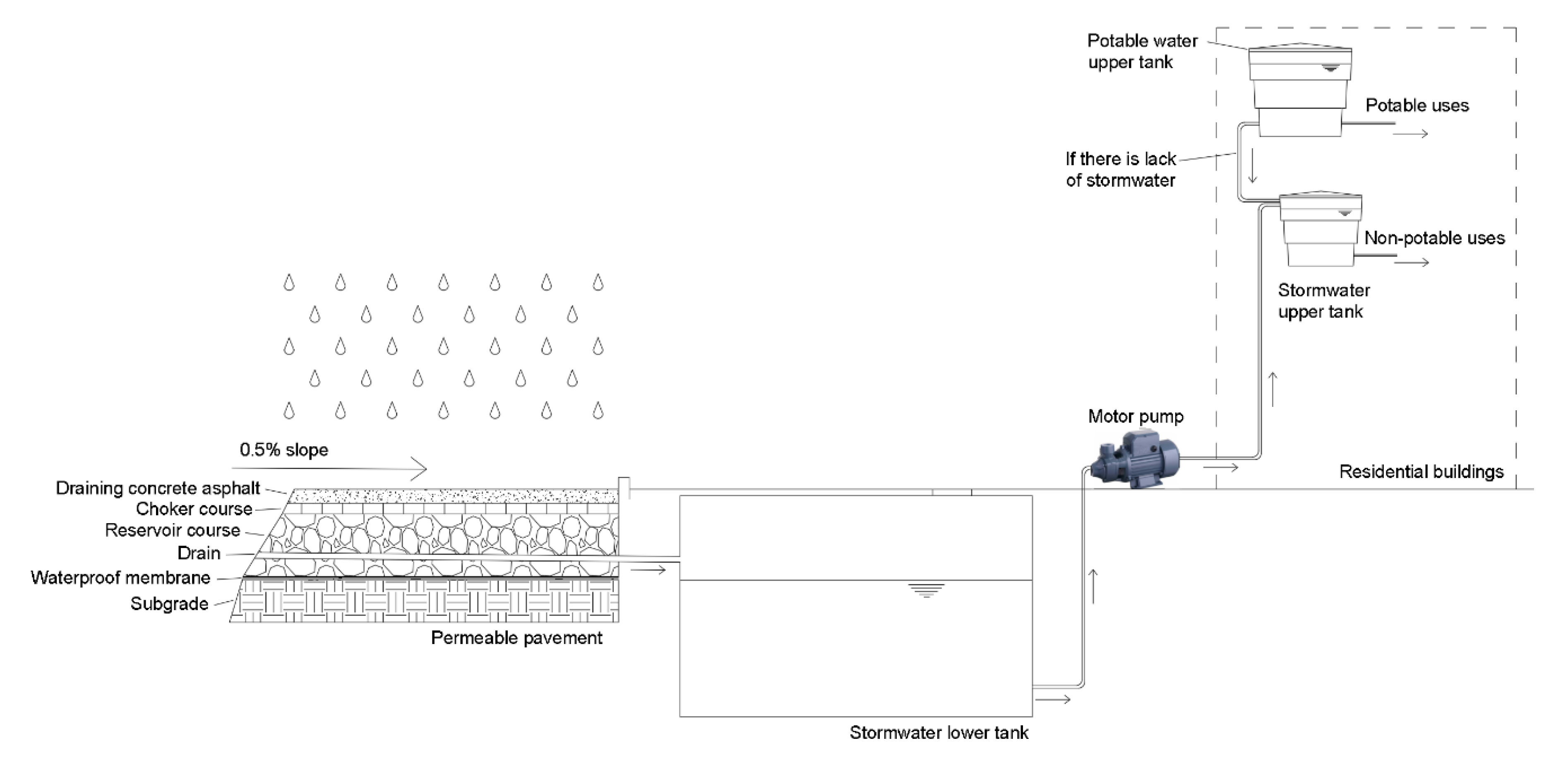
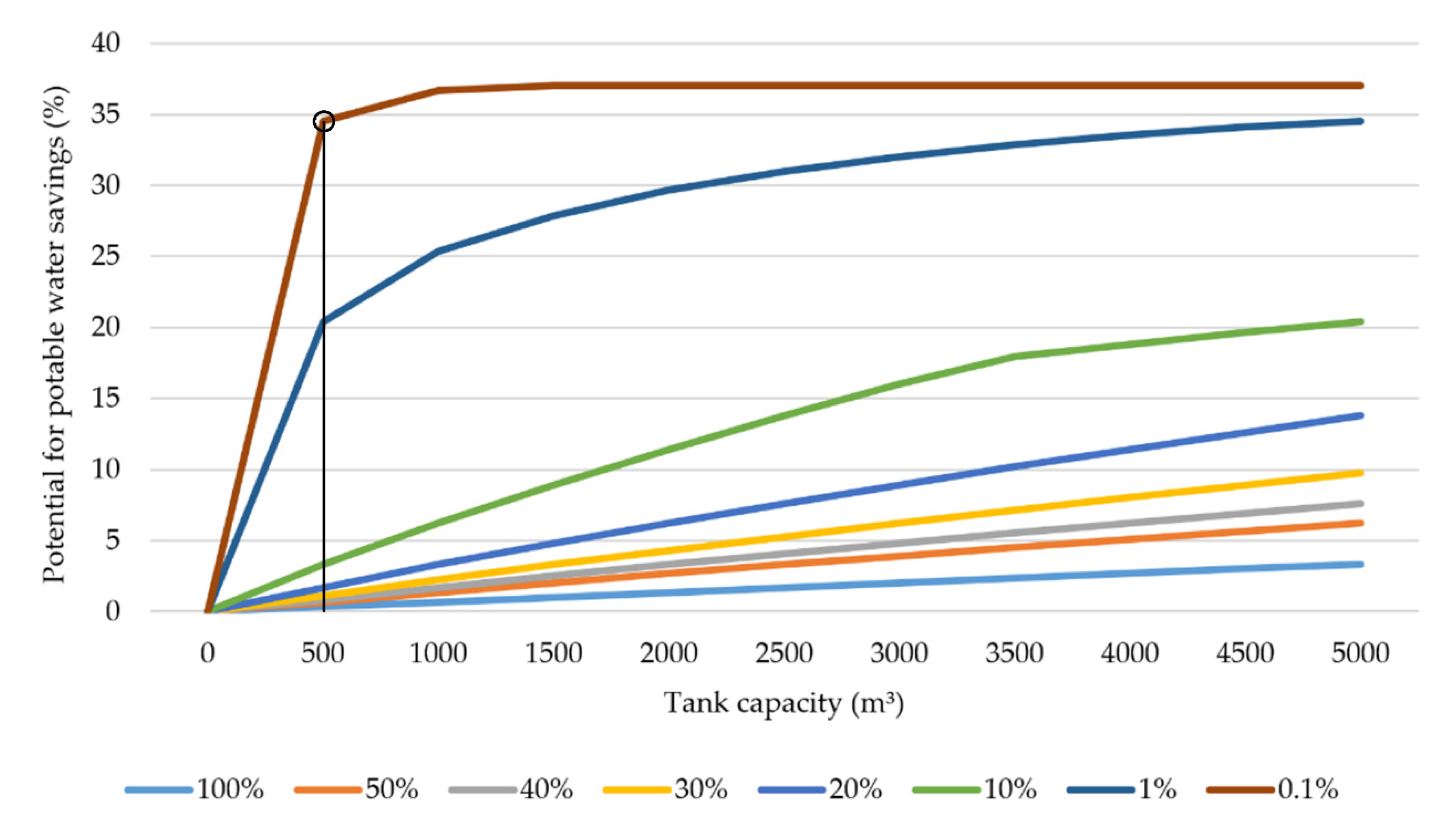
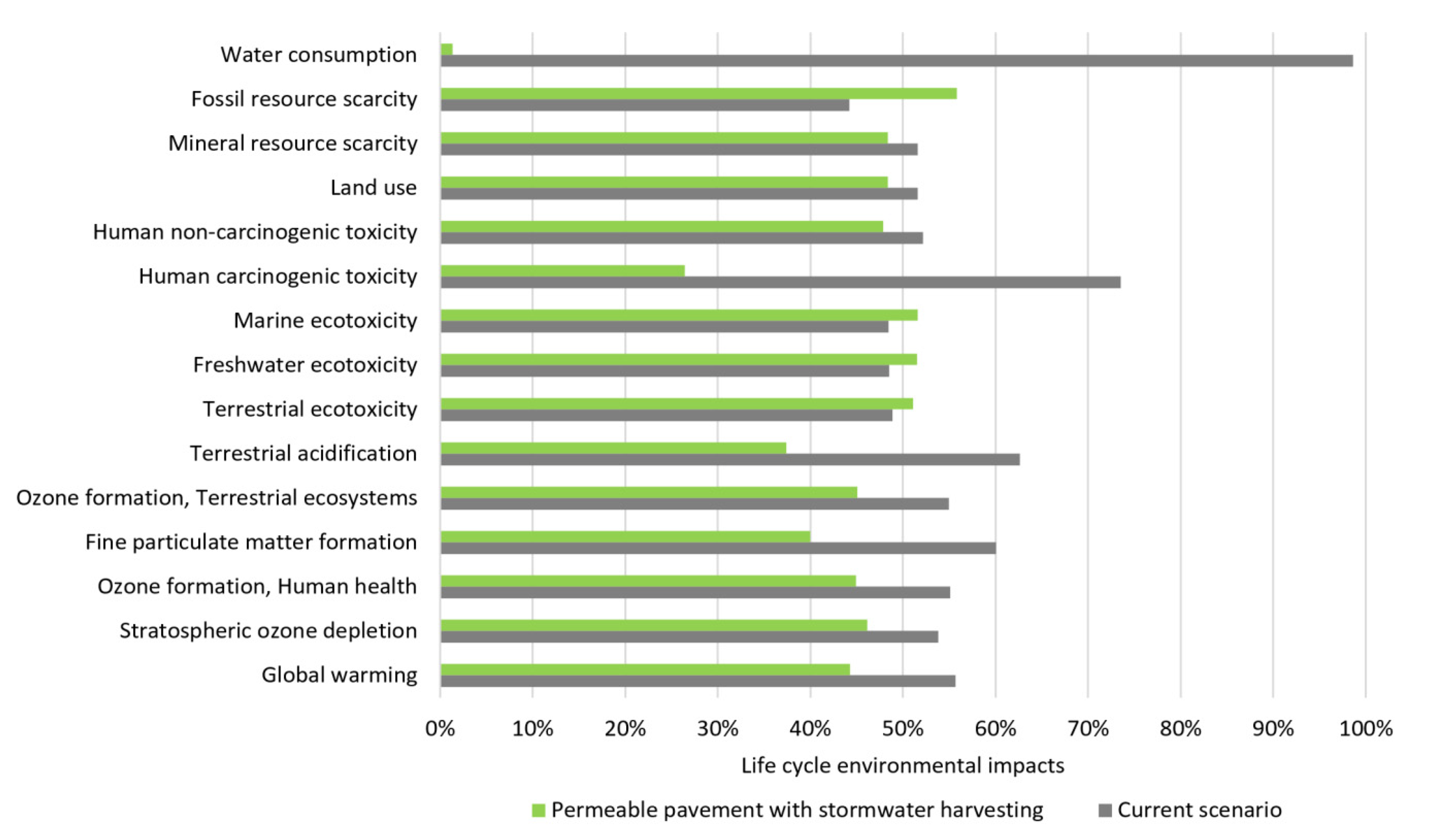
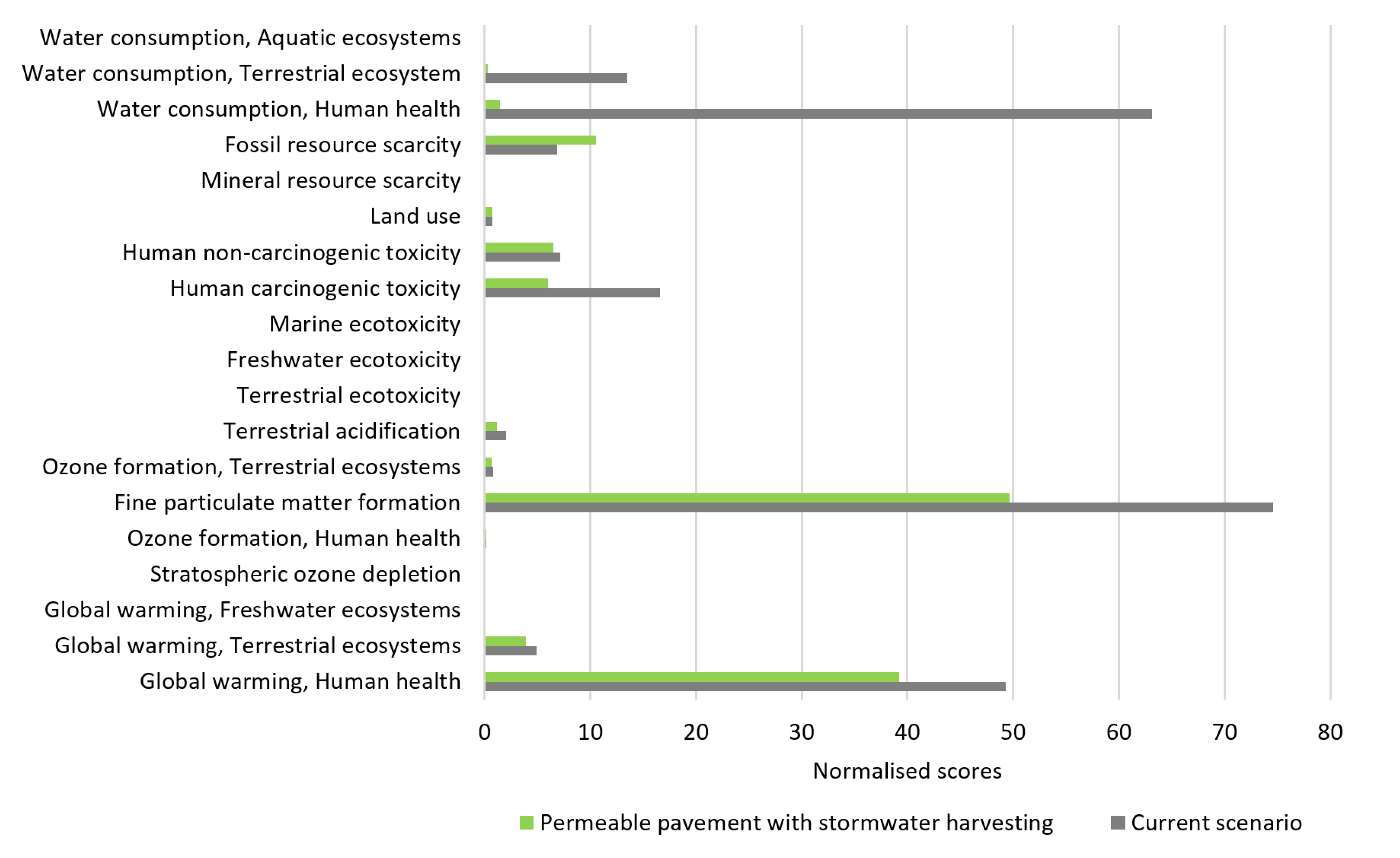
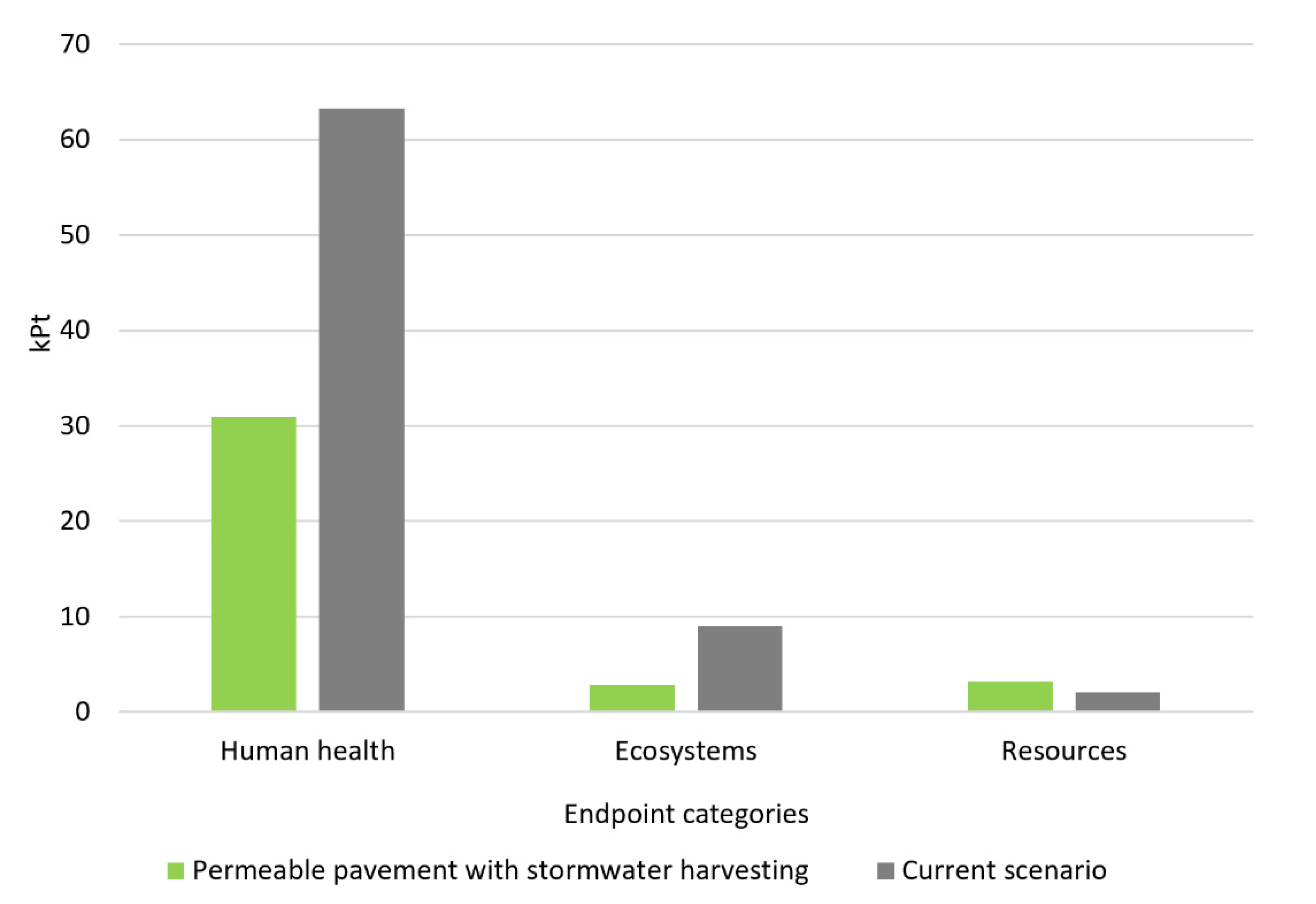
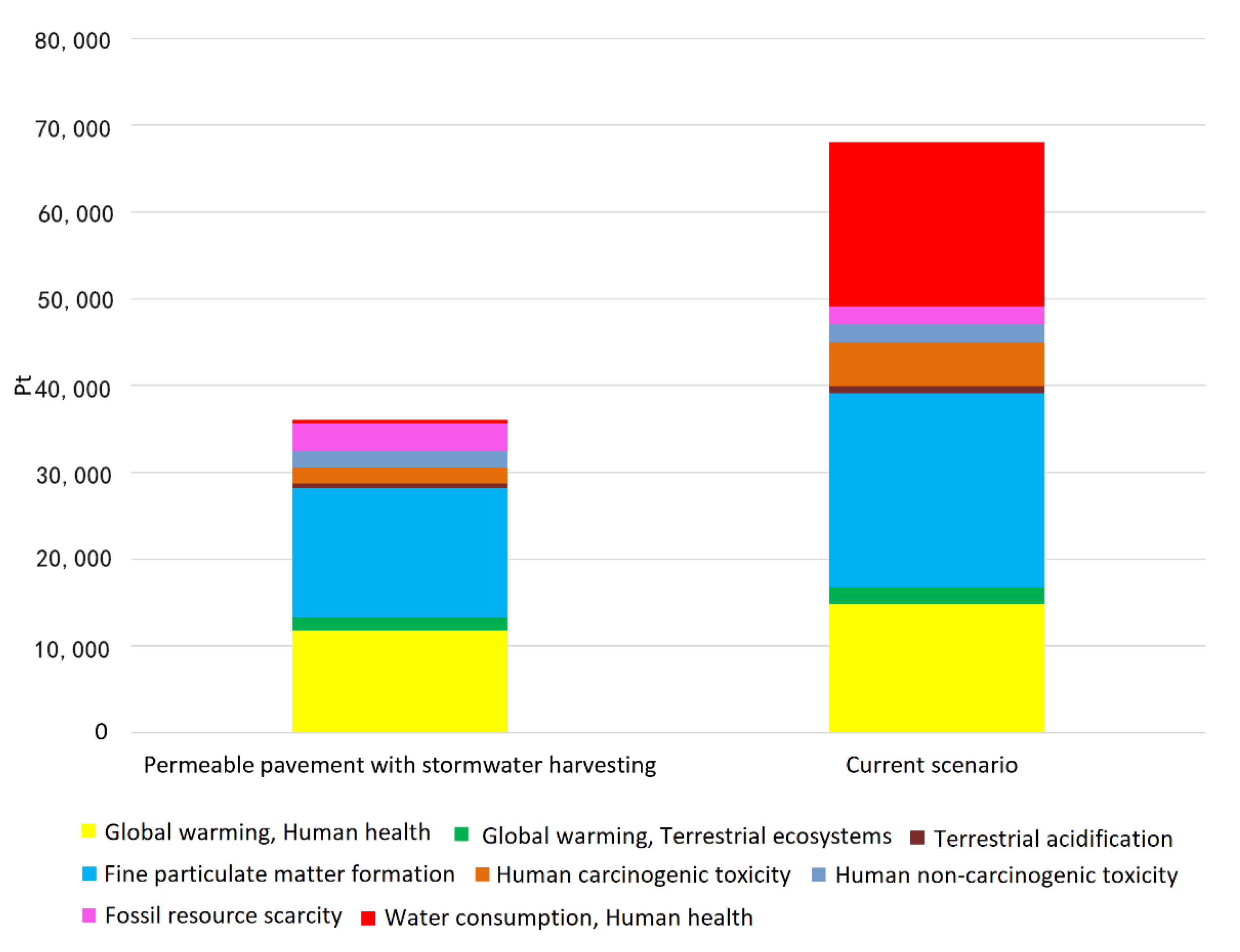
| Water End-Use | Proportion of Total Daily Use (%) | Amount of Water Used (L/Day per Person) | Amount of Water Used in Glasgow (L/Day) |
|---|---|---|---|
| Flushing toilets | 30 | 45.0 | 27,528,660 |
| Taps (including baths) | 21 | 31.5 | 19,270,062 |
| Washing machines | 13 | 19.5 | 11,929,086 |
| Showers | 12 | 18.0 | 11,011,464 |
| Drinking and other uses (e.g., cooking) | 9 | 13.5 | 8,258,598 |
| Washing up | 8 | 12.0 | 7,340,976 |
| Outdoor use (garden etc.) | 7 | 10.5 | 6,423,354 |
| Total | 100 | 150.0 | 91,762,200 |
| Paved Roads (%) | Paved Roads (m²) | Water Consumption (L/Day) | Community Size |
|---|---|---|---|
| 100 | 28,505,175 | 91,762,200 | 611,748 |
| 50 | 14,252,588 | 45,881,100 | 305,874 |
| 40 | 11,402,070 | 36,704,880 | 244,699 |
| 30 | 8,551,553 | 27,528,660 | 183,524 |
| 20 | 5,701,035 | 18,352,440 | 122,350 |
| 10 | 2,850,518 | 9,176,220 | 61,175 |
| 1 | 285,052 | 917,622 | 6117 |
| 0.1 | 28,505 | 91,762 | 612 |
| Components | Material | Quantity | Unit Cost (£) | Total Cost (£) |
|---|---|---|---|---|
| Upper stormwater tanks | HDPE | 295 × 500 L | 276.00 | 81,420.00 |
| Lower stormwater tank | Concrete | 225 m³ | 150.00 | 33,750.00 |
| Formwork wood | 390 m² | 75.00 | 29,250.00 | |
| Steel bar | 34.87 ton | 4280.00 | 149,243.60 | |
| Geotextile | 425 m² | 6.00 | 2550.00 | |
| Drain | Precast concrete | 2136 m | 100.00 | 213,600.00 |
| Asphalt coating | Stone dust | 613 m³ | 165.60 | 101,512.80 |
| Aggregates (4.8–9.5 mm) | 812 m³ | 165.60 | 134,467.20 | |
| Asphalt binder | 470 m³ | 1240.00 | 582,800.00 | |
| Choker course | Aggregates 19 mm | 855 m³ | 165.60 | 141,588.00 |
| Reservoir course | Aggregates 37 mm | 7468 m³ | 165.60 | 1,236,700.80 |
| Waterproof membrane | Geotextile | 28,505 m² | 6.00 | 171,030.00 |
| Pipes | PVC | 3835 m | 82.00 | 314,470.00 |
| Connections | PVC | 162 kg | 290.00 | 46,980.00 |
| Solenoid valve | PVC | 1 unit | 276.00 | 276.00 |
| Overflow siphon | PE | 1 unit | 40.00 | 40.00 |
| Floating set of suction | Silicon | 1 unit | 858.00 | 858.00 |
| Floating chlorinator | PS | 1 unit | 770.00 | 770.00 |
| Register | Brass | 1 unit | 1300.00 | 1300.00 |
| Water pumps | Cast iron | 2 units | 2800.00 | 5600.00 |
| Level electro buoy | HDPE | 1 unit | 270.00 | 270.00 |
| Total initial costs | 3,248,476.40 | |||
| System | Components | Material | Quantity | Unit Cost (£) | Total Cost (£) |
|---|---|---|---|---|---|
| Pavement | Asphalt coating | Hot Mix Asphalt | 1425 m³ | 648.42 | 923,998.50 |
| Base | Crushed stone | 4276 m³ | 165.60 | 708,105.60 | |
| Sub-base | Stabilized soil | 4276 m³ | 165.50 | 707,678.00 | |
| Drainage | Concrete for gutters | Concrete | 22.9 m³ | 150.00 | 3435.00 |
| Precast concrete | Concrete | 143 m³ | 150.00 | 21,450.00 | |
| Formwork | Wood | 26 m² | 75.00 | 1950.00 | |
| Sand for mortar | Sand | 4.40 m³ | 165.60 | 728.64 | |
| Cement for mortar | Cement | 946 kg | 2.18 | 2062.28 | |
| Brick 5 × 10 × 20 cm | Brick | 10,080 units | 0.86 | 8668.80 | |
| Precast concrete pipes | Concrete | 3880 m | 100.00 | 388,000.00 | |
| Total initial costs | 2,766,076.82 | ||||
© 2020 by the authors. Licensee MDPI, Basel, Switzerland. This article is an open access article distributed under the terms and conditions of the Creative Commons Attribution (CC BY) license (http://creativecommons.org/licenses/by/4.0/).
Share and Cite
Antunes, L.N.; Sydney, C.; Ghisi, E.; Phoenix, V.R.; Thives, L.P.; White, C.; Garcia, E.S.H. Reduction of Environmental Impacts Due to Using Permeable Pavements to Harvest Stormwater. Water 2020, 12, 2840. https://doi.org/10.3390/w12102840
Antunes LN, Sydney C, Ghisi E, Phoenix VR, Thives LP, White C, Garcia ESH. Reduction of Environmental Impacts Due to Using Permeable Pavements to Harvest Stormwater. Water. 2020; 12(10):2840. https://doi.org/10.3390/w12102840
Chicago/Turabian StyleAntunes, Lucas Niehuns, Calum Sydney, Enedir Ghisi, Vernon R. Phoenix, Liseane Padilha Thives, Christopher White, and Emmanuelle Stefânia Holdefer Garcia. 2020. "Reduction of Environmental Impacts Due to Using Permeable Pavements to Harvest Stormwater" Water 12, no. 10: 2840. https://doi.org/10.3390/w12102840
APA StyleAntunes, L. N., Sydney, C., Ghisi, E., Phoenix, V. R., Thives, L. P., White, C., & Garcia, E. S. H. (2020). Reduction of Environmental Impacts Due to Using Permeable Pavements to Harvest Stormwater. Water, 12(10), 2840. https://doi.org/10.3390/w12102840








